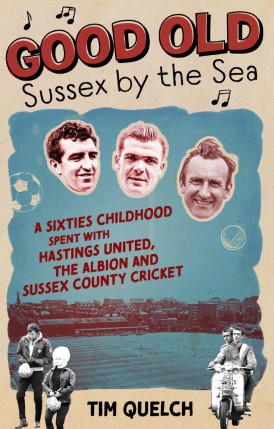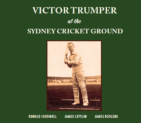Good Old Sussex By The Sea
Martin Chandler |Published: 2020
Pages: 283
Author: Quelch, Tim
Publisher: Pitch
Rating: 4 stars

Good Old Sussex By The Sea is Tim Quelch’s third book and, as with the other two, no one can accuse him of lacking imagination in choosing titles. The first, Bent Arms and Dodgy Wickets, was an entertaining look at English Test cricket between 1946 and 1959. Three years later Stumps and Runs and Rock ’n’ Roll appeared. This was written in a similar entertaining style and, with its year on year look at the music scene in addition to its cricketing review, contained some autobiographical elements as well.
Quelch’s latest is more like his second book than his first, although rather more personal. This time he delves into his childhood and in addition to glimpses at his own life he tells the story, from the early 1950s to the late 1960s, of the three sports clubs that he followed through that period. They were two soccer clubs, Hastings United FC of the Southern League and Brighton and Hove Albion FC of the Football League and, in the summer months, Sussex County Cricket Club.
In truth Good Old Sussex By The Sea is much less of a cricket book than its predecessors, less than a fifth of its content being taken up with the chapters on Sussex cricket. Perhaps the simple reality is that the matches the young Quelch saw tended to be, in the manner of the times, relatively pedestrian. That said he chose a fine match against Lancashire in 1961 as his first, and later chapters are devoted to a stunning victory over Garry Sobers’ 1966 West Indians and, in 1968, Quelch witnessing a remarkable innings from Ted Dexter.
To all intents and purposes Dexter retired from cricket in 1965 at the age of just 30, but he was persuaded to return a couple of years earlier, lured back with a promise of being able to take one last tilt at the Australians. There was just one county match before the fourth Test, against Kent at Hastings. Quelch was unable to resist this last opportunity to take a look at one of his heroes in action and decided to attend. He saw his team slump to 27-4 against an attack that included Derek Underwood, and then witnessed a recovery that was dominated by an imperious double century from Dexter who was duly selected for the last two Tests. There was no match changing Ashes innings from ‘Lord Ted’ but, his getting into double figures in each of his four innings, his return was far from a failure.
The bulk of Good Old Sussex By The Sea is, however, concerned with football. As the years have passed my interest in our national sport has waned, but as a schoolboy I was as keen as anyone. The era that Quelch covers here was just before my time and, as fascinated by football as I was throughout my childhood the history of the sport never gripped me in the way that cricket’s past did.
I have to say however that I much enjoyed Quelch’s look back at the the professional game. In those days footballers were not paid in the way they are today, and indeed for much of the period with which Quench is concerned there was a maximum wage. The existence of that, and Jimmy Hill’s successful campaign to abolish it was something I knew about, but until now never really fully understood. Another aspect was the almost feudal relationship of master and servant that existed between the players and the clubs, who were most certainly in charge of their players, also vividly illustrated by Quelch.
Something else I now understand much better from reading Good Old Sussex By The Sea is the betting scandal of the 1960s and why it occurred. Again I knew a little, that the so called Sheffield Wednesday three had been jailed for betting against their own side, but the detail had until now passed me by.
The contrast between footballers’ careers then and now is a fascinating one. These days even the moderately talented can, as long as they stay injury free, earn enough in a playing career to achieve financial security for life. As Quelch explains that was not always the case. In the 1950s and 1960s all but the very best, and even some of those would, as age caught up with them, slowly slip down the leagues in order to keep on playing and earning. A highlight of the book is an account of a game between Yiewsley (now Hillingdon Borough) and Hastings United in 1962 – Yiewsley’s 38 year old player manager was the legendary Jackie Milburn.
Enjoyable as the chapters on Brighton are the chapters of Good Old Sussex By The Sea that I enjoyed most were those on the subject of Hastings United. Formed only in 1948 Quelch is able to tell the complete story of a club which folded in 1985. They played in the Southern League, were to all intents and purposes a fully professional club and, in their early days at least would regularly attract substantial crowds to their Pilot Field ground. The ups and downs of a club that seems to have had more than its fair share off field troubles make for compelling reading, and in particular the accounts of stirring runs in the FA Cups of 1953/54 and 1954/55.
In 1968 Quelch left Sussex to go to University in Lancaster and remained in the north. His affinity for the county of his formative years never dulled however and his closing chapters are a summary that bring the stories of his three clubs into the twenty first century. Despite the sad demise in 1985, and once more as a consequence of events I knew nothing about, there is still a Hastings United FC playing at Pilot Field, and that is another interesting part of the club’s story.
As ever the Publishers, Pitch, are to be congratulated on the quality of their finished product which contains an excellent selection of photographs. For anyone who enjoyed Tim Quelch’s previous books this one will prove a worthwhile purchase and if, as I suspect, his next is a history of Burnley FC, I am confident that that will be a good ‘un as well.






I looked forward to this book but was rather disappointed as it was essentially a reminiscence on Hastings United with incidental reference to Brighton and Hove Albion and Sussex CCC, the real interest and the reason I bought the book. There were some challenging ideas; the cosy gloss of childhood perspective, the relatively low social and economic status of footballers immediately after the abolition of the maximum wage and the inherent parochialism of following ones local team. However, I felt that once Mr Quelch left for University the story was left hanging with no conclusion. The remaining period was a brief reprise rather than analysis of his childhood impressions through the advantage of historical retrospect. There is a germ of a good idea here; the duality of football/cricket and its pre-occupation in childhood. The role/dichotomy of the footballer/cricketer professional current till 1970 is touched upon and is worthy of further critical analysis. For people like me, we await a biography of Tommy Cook which could address this topic
Comment by Gerry Martin | 2:15pm BST 11 April 2020